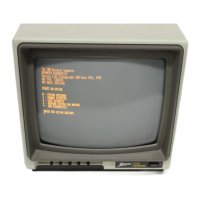Page
4-1
THEORY OF OPERATION
Refer to
the
fold-out schematic diagram (page 6-7)
and
the block diagram
in
Figure 4-1 (fold
out
from
Page 4-3) as
you
read the following information.
POWER SUPPLY
Power transformer TX201
and
bridge diodes
CRX701, CRX702, CRX703,
and
CRX704 develop ap-
proximately 17.5 volts
DC
on
capacitor CX707,
with
1.7 volts of
ripple
present. QX703 acts as a variable
series element, dropping more
or
less voltage accross
it
in
order
to
maintain
the
output
voltage at a con-
stant
12.7 volts.
When
the
output
voltage increases
or
decreases
due
to line voltage fluctuations
or
load
variations, this
voltage change appears at
the
base of Q701.
The
volt-
age
divider
network
that
feeds
this
voltage to
the
base is
made
up
of R704, R706, R707, R708, RX709,
and
C709.
The
potentiometer is configured to
minimize
voltage drift caused
by
tolerances
or
tem-
perature variations. The
AC
ripple
is
coupled
to
the
base
by
C709. This voltage is
compared
against
the
reference of CR706 (4.7-volt zener)
and
C708. Any
difference causes
the
collector
current
to increase
or
decrease proportionally. This
current
is amplified
by
Q702
and
fed to control transistor QX703.
If
the
output
voltage tries to rise, Q701
will
try
to
turn
off, causing Q702
and
Q703 to
turn
off. Conversely,
when
the
output
voltage drops, Q701
turns
on
hard-
er,
turning
on
Q702
and
Q703
and
raising
the
output
voltage
back
to normal.
A
unique
feature of this circuit is its ability to
switch
from a regulator to
an
active filter
at
low
line
volt-
ages.
The
voltage
at
the collector of Q702 is propor-
tional to
the
available
input
voltage to
the
regulator.
When
the
input
is too
low
to
maintain
12.7 volts,
the
voltage
at
the
collector of Q702
drops
below
the
reference
zener
voltage, causing CR705 to conduct.
This
additional
current
sinking
through
R701 dis-
ables
the
zener
reference, causing
the
DC
output
voltage to
drop
and
no
longer be regulated for
DC
variations. However, the AC reference remains
in
control;
so
AC
ripple
regulation
continues
-
in
effect -
producing
an
active filter.
VIDEO PREAMP
The
video
input
is configured to
accept
a
standard
RS170 composite video
with
a 75-ohm terminating
input.
The
video is
coupled
to
the
emitter
of Q806
through C814
and
R835. Q806 is a common-base
amplifier
which
amplifies
the
one-volt peak-to-peak
video to
three
volts
without
a
phase
inversion.
The
output
of Q806 is
coupled
through C808 to
the
base
of
the
video driver (Q805).
In
the
base
circuit of
Q805, a
sync
tip
clamp; consisting of CR804, R814,
R815,
and
R820; is
used
to
clamp
the
video signal
so there are
no
black level shifts
with
variation
in
input
signal.
SYNC
AMP
The
video signal at
the
emitter of video
driver
Q805
is sent to
the
video
output
through
the
Contrast con-
trol. It is also
sent
to
the
base of
the
sync amplifier
Q801.
The
sync amplifier is
used
to
stretch
the
sync
portion of
the
video signal before
the
signal is
sent
to the sync separator, Q802. Q802 is a
standard
dual-
time-constant sync separator. Its
output
is
sent
to
the
horizontal
and
vertical oscillators to keep
the
deflection
in
sync.

